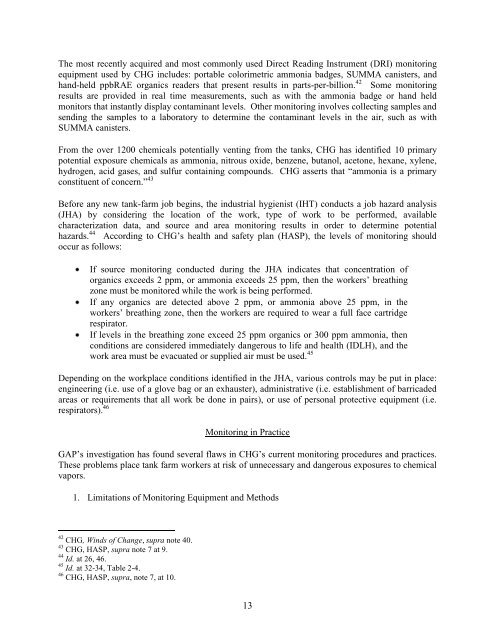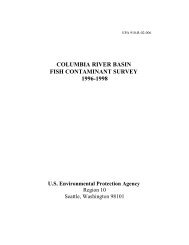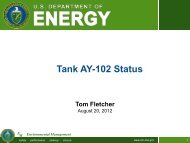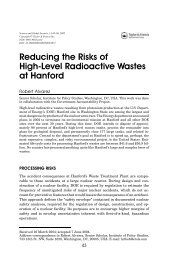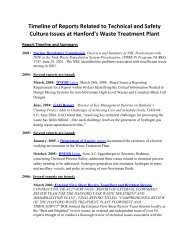Knowing Endangerment - Hanford Challenge
Knowing Endangerment - Hanford Challenge
Knowing Endangerment - Hanford Challenge
You also want an ePaper? Increase the reach of your titles
YUMPU automatically turns print PDFs into web optimized ePapers that Google loves.
The most recently acquired and most commonly used Direct Reading Instrument (DRI) monitoring<br />
equipment used by CHG includes: portable colorimetric ammonia badges, SUMMA canisters, and<br />
hand-held ppbRAE organics readers that present results in parts-per-billion. 42 Some monitoring<br />
results are provided in real time measurements, such as with the ammonia badge or hand held<br />
monitors that instantly display contaminant levels. Other monitoring involves collecting samples and<br />
sending the samples to a laboratory to determine the contaminant levels in the air, such as with<br />
SUMMA canisters.<br />
From the over 1200 chemicals potentially venting from the tanks, CHG has identified 10 primary<br />
potential exposure chemicals as ammonia, nitrous oxide, benzene, butanol, acetone, hexane, xylene,<br />
hydrogen, acid gases, and sulfur containing compounds. CHG asserts that “ammonia is a primary<br />
constituent of concern.” 43<br />
Before any new tank-farm job begins, the industrial hygienist (IHT) conducts a job hazard analysis<br />
(JHA) by considering the location of the work, type of work to be performed, available<br />
characterization data, and source and area monitoring results in order to determine potential<br />
hazards. 44 According to CHG‟s health and safety plan (HASP), the levels of monitoring should<br />
occur as follows:<br />
If source monitoring conducted during the JHA indicates that concentration of<br />
organics exceeds 2 ppm, or ammonia exceeds 25 ppm, then the workers‟ breathing<br />
zone must be monitored while the work is being performed.<br />
If any organics are detected above 2 ppm, or ammonia above 25 ppm, in the<br />
workers‟ breathing zone, then the workers are required to wear a full face cartridge<br />
respirator.<br />
If levels in the breathing zone exceed 25 ppm organics or 300 ppm ammonia, then<br />
conditions are considered immediately dangerous to life and health (IDLH), and the<br />
work area must be evacuated or supplied air must be used. 45<br />
Depending on the workplace conditions identified in the JHA, various controls may be put in place:<br />
engineering (i.e. use of a glove bag or an exhauster), administrative (i.e. establishment of barricaded<br />
areas or requirements that all work be done in pairs), or use of personal protective equipment (i.e.<br />
respirators). 46<br />
Monitoring in Practice<br />
GAP‟s investigation has found several flaws in CHG‟s current monitoring procedures and practices.<br />
These problems place tank farm workers at risk of unnecessary and dangerous exposures to chemical<br />
vapors.<br />
1. Limitations of Monitoring Equipment and Methods<br />
42 CHG, Winds of Change, supra note 40.<br />
43 CHG, HASP, supra note 7 at 9.<br />
44 Id. at 26, 46.<br />
45 Id. at 32-34, Table 2-4.<br />
46 CHG, HASP, supra, note 7, at 10.<br />
13


